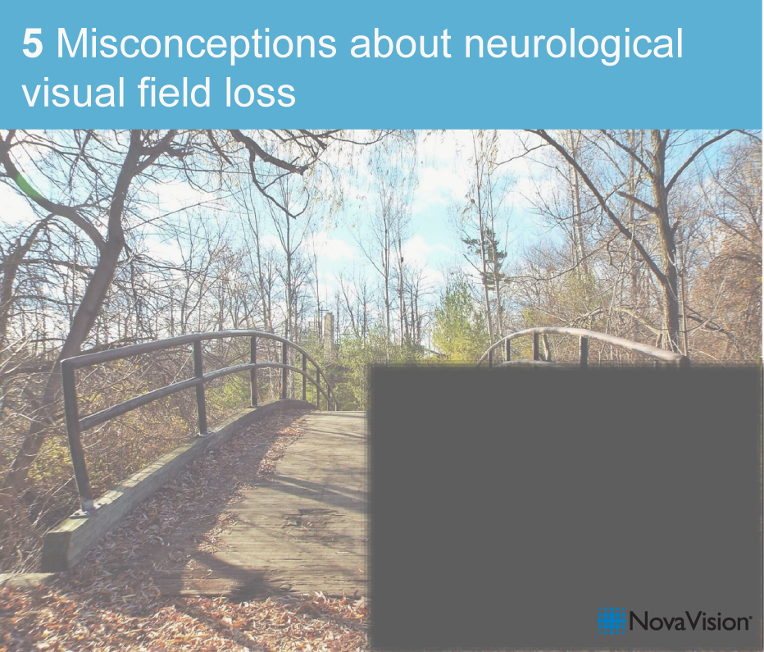
Many of those who have had a stroke or other brain injury will experience vision problems, but often times they will not realize they have a visual field deficit.
Their brains may adjust to process visual information coming from the seeing part of their visual field and then be surprised to encounter objects in the blind area. They or their loved ones might not know what the cause is and may find it difficult to find information on neurological field loss to help them understand what is happening, and there are many misconceptions that people have. This blog will help to clear up these misconceptions.
1. Right homonymous visual field loss means that one cannot see with the right eye (or left, respectively).
A homonymous visual field loss resulting from a brain injury does not affect the eye itself, but interferes with transportation of the visual information from the eyes to the brain. Because of the unique anatomical structure of the visual pathway transporting this information from the eye to the visual cortex of the brain, damage to this pathway will typically affect both eyes on either the,right or left side. Homonymous visual field loss always means vision loss to the right or to the left in BOTH eyes.
2. With homonymous hemianopia one should be allowed to drive because people with only one functioning eye are allowed to drive and that is the same vision problem.
As explained above, homonymous visual field loss such as hemianopia affects the same half of both eyes. Driving regulations require a CONTINUOUS visual field of a certain size. This requirement is met with an intact visual field of one eye, but not with visual field loss in both eyes. With disconnected visual fields it is a lot harder to keep a continuous field of view over the affected side.
3. With homonymous hemianopia to the right, the right half of the person’s visual field is now black (or left respectively).
People suffering from neurological vision loss, for example hemianopia to the right, describe their visual experience differently. Some see the area of vision loss as being black, many describe it as simply “gone”. Just like a healthy person cannot see behind their back, they cannot see beyond their central visual fixation point. Others have visual images in the area of vision loss, wavering lines, or patterns, or light reflexes. Some feel they see everything through a very thick fog, blurry and colorless. The way the visual field defect is processed in the brain might be different for everybody.
4. One cannot believe that a person whose eyes move and focus normally and look perfectly healthy is suffering from severe vision problems in all daily life activities. Surely they are exaggerating?
This is a problem for many people suffering from visual field loss. There is nothing in their outer appearance that would suggest a disability. Therefore, people are not considerate of their disability and assume intact vision. People expect them to see them and sidestep to avoid collisions, or if they know each other to recognize them and greet them. If not, they might get angry or offended. Even close relatives might not be aware of the size of the impairment and do not understand why the person with visual field loss is reluctant to take part in social activities such as going to the cinema or to a restaurant. Visual field loss can lead to significant insecurity, particularly in situations that require a good visual overview.
5. Visual field loss resulting from stroke or other brain injury is untreatable.
Although spontaneous recovery is possible within the first three months the vast majority of patients need specific therapeutic intervention.
NovaVision’s Vision Restoration Therapy (VRT) is the only FDA cleared therapy for the restoration of lost vision due to neurological brain damage such as stroke or other brain injury. NovaVision provides VRT in a therapy suite that also includes NeuroEyeCoach, an eye movement-training program that is also FDA registered. VRT has been demonstrated through extensive clinical data to actually help restore lost vision while NeuroEyeCoach helps the patient make the most of their remaining vision. NovaVision provides the therapies together to maximize patient benefit.
Although VRT is backed by decades of scientific research, not every physician is necessarily aware of the therapy and the potential benefits for you, the patient. This ebook will walk you through what causes vision loss after a stroke or TBI, whether or not VRT and NeuroEyeCoach is the right solution for you, and if appropriate how to move forward pursuing this therapy with your doctor.
Written by: Sigrid Kenkel


